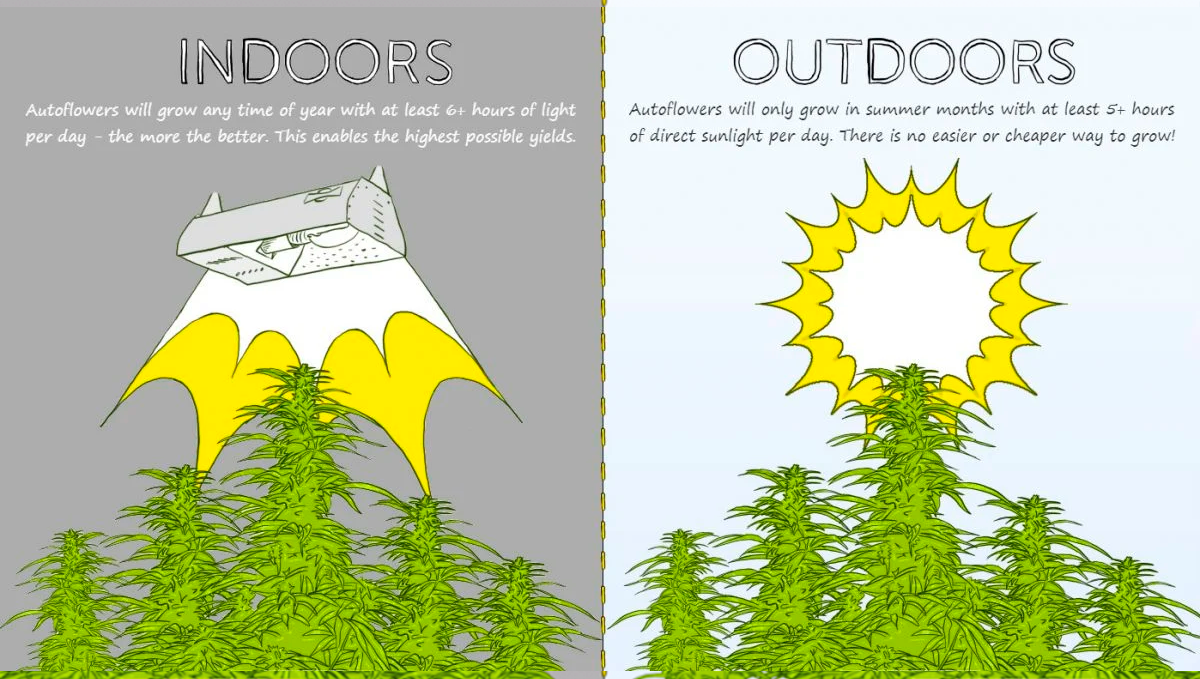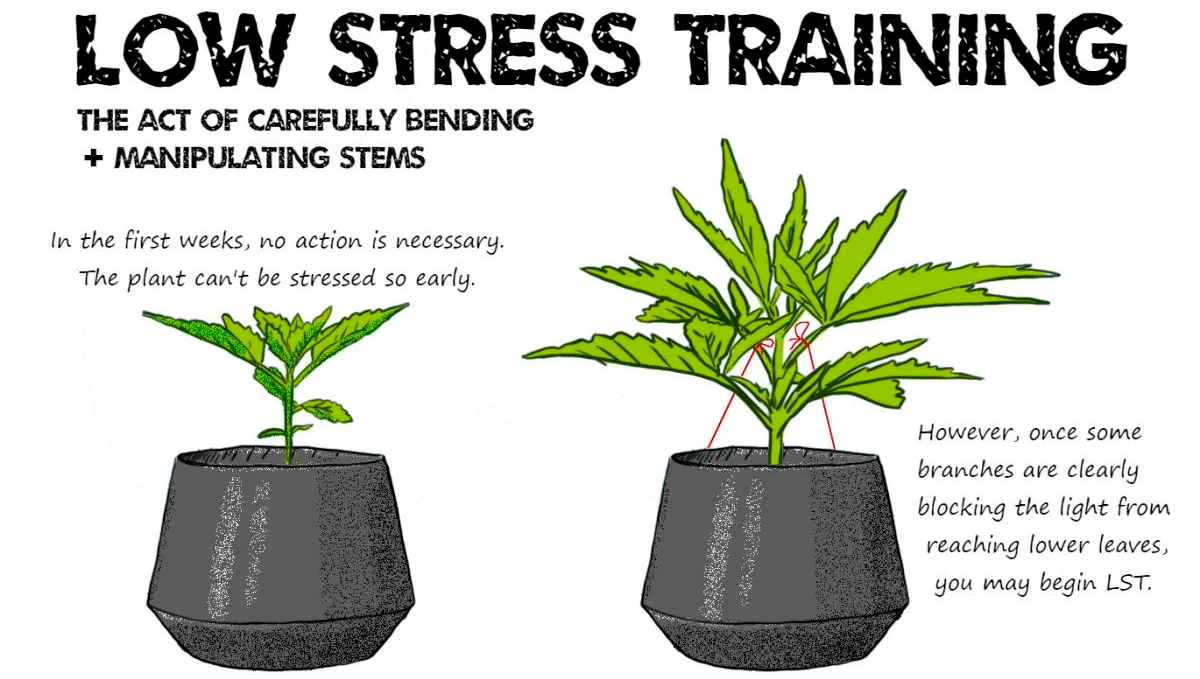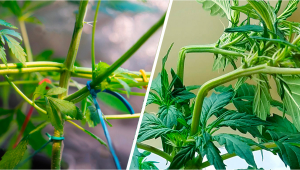All About Autoflowers - Growth Factors

- 1. Lighting requirements
- 2. Plant training techniques
- 3. Microbial symbiosis
1. Lighting Requirements
As we explained in Part One: Evolving and Growing, all autoflowering marijuana benefits from Ruderalis genes -- enabling faster, more resilient grows with no requirement to alter light schedules to trigger flowering. The evolution of autoflower strains means that you can achieve seriously impressive yields if you apply optimal conditions and the appropriate techniques. These growth factors are simple to understand, and we hope they convert many growers to the autoflower cause. Once a seed has germinated and been planted, it should be kept in the same environment until harvest day. Autoflowers do not react well to ‘transplanting’. The #1 rule is that more hours of light is better. This is the main reason why indoor grows tend to produce more, even if LED lights will never match the almighty power of sunlight. You can give an autoflower 24 hours of light indoors, but only around half that outdoors.

While this is a heavily contested topic among autoflower cultivators, the general consensus these days is that a light regime of 18/6 (that’s 18 hours of light to 6 hours of darkness) or 20/4 is what allows for the best results come harvest. Although autos will complete their full lifecycle under any lighting conditions, most growers agree that 24/0 can have some negative effects in terms of yield size and the potency of the buds. Just like us, weed plants need at least some time to rest. Just give the plant all the light you can (no more than 20 hours per day though if growing indoors) and the correct amount of water and nutrients at the correct pH range, and being an autoflower, it will automatically flower in a matter of weeks. However, to maximize the growth potential, there are a few tricks you can try.
Of course, if you remember anything from biology class, you’ll know that plants need light in order to conduct the key physiological process which is photosynthesis. However, plants aren't alone in this impressive feat, algae and some forms of bacteria also use sunlight to create their own energy supply. During this process of photosynthesis, plants use energy from the light they absorb and use it to transform carbon dioxide from the atmosphere and water from the soil to create sugar and oxygen. This process benefits plants in many different ways. The energy they obtain allows them to grow, repair damaged tissues, and become as productive as possible.
2. Plant training Techniques
“Low-Stress Training” or LST is basically the method of gently bending down (and holding in place with soft string or furry wire ties) the branches so that they form a wider canopy -- which means each branch receives more light. Unlike HST techniques such as topping, fimming, super cropping, etc. this form of training is not meant to hurt the plant in any way. This is important for autoflowering cannabis strains as they do not have the vegging growth time to recover from such invasive forms of training.
LST is best applied progressively, every few days, while branches are still flexible enough to bend easily. Bending towards the ends of branches is easiest. You will gradually achieve the optimal plant shape as each bent branch naturally arches upwards towards the light. First-time autoflower growers are advised against “topping” the plant before LST (this means entirely cutting off the tallest branch to promote a flatter, more substantial overall growth). Autoflowers have shorter growth spans and less time to recover from shocks. However, with more experience and a healthy, fast-growing plant with at least 4 nodes (pairs of main leaves), it can be fine to just snip the tip (a collection of tiny leaves).

“FIMing” is a less extreme version of topping. Instead of slicing off the top stem, you merely shave the very top of the tip and cause the plant less stress. The downside is that, unlike topping, FIMing is unlikely to result in a split main stem (i.e. two main colas). “No technique” training is LST at its most basic -- bending the main stem very early on, so that the whole plant grows along a horizontal axis and no further LST is required.
Strategic defoliation of indoor plants (not usually necessary when growing under the sun, which moves across the sky) is essentially the snipping of leaves during the critical early flowering stage of your buds’ growth, to give the greatest number of the extra light and air. As mentioned above, you are more than welcome to experiment with whatever training technique you please, but any form of HST may lead to detrimental effects with autos. Fast Buds offers three “XXL yield” strains: the Six Shooter and Tangie'matic -- and now the newly unleashed Blue Dream'matic!
3. Microbial Symbiosis
Small soil-dwelling organisms also play a key part in cannabis health and optimal growth. Did you know that there's a whole bunch of tiny creatures called microbes that help cannabis plants grow big and strong? That's right, these little guys play a big role in keeping your weed healthy and happy. First off, let's talk about the soil. Microbes in the soil help break down organic matter, like dead leaves and other plant debris, into nutrients that the cannabis plant can use. They also help the plant absorb those nutrients more efficiently, so it can grow faster and stronger. But it's not just about the soil. Microbes can also live on the surface of the plant itself. These beneficial bacteria and fungi help protect the plant from harmful pathogens and pests, like mold and insects. They can even help improve the plant's natural defense mechanisms, making it more resistant to disease.
One type of microbe that's especially helpful for cannabis plants is mycorrhizal fungi. These fungi form a symbiotic relationship with the plant's roots, forming tiny threads that help the plant absorb nutrients and water from the soil. They can even help the plant deal with environmental stress, like drought or nutrient deficiency. Another group of microbes that can help cannabis plants thrive is nitrogen-fixing bacteria. These little guys take nitrogen from the air and convert it into a form that the plant can use. You can use microbes to your advantage in many different ways as a grower for better results, including by inoculating transplants with mycorrhizal fungi and Trichoderma, and applying compost tea as a foliar spray.












Comments